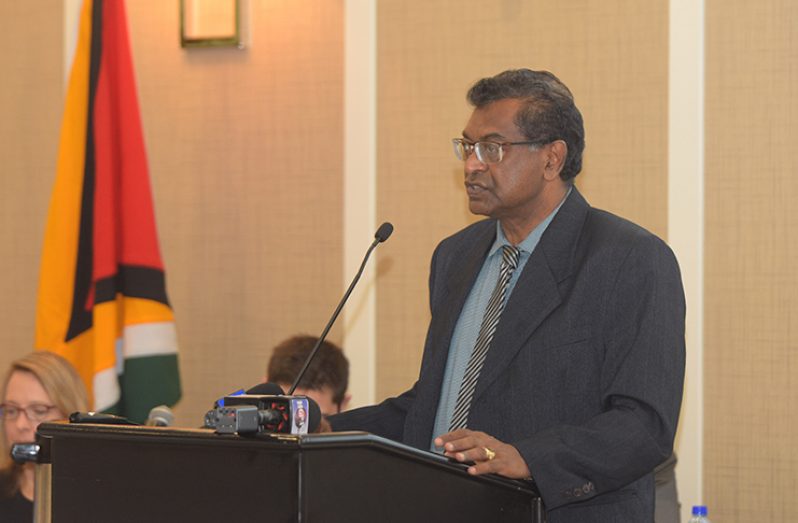…drug-related offences second leading cause for incarceration
INCARCERATION, which is a punitive response for non-violent drug offenders, should be reduced and replaced with treatment and rehabilitation instead and this should be supervised by Drug Treatment Courts, according to Minister of Public Security Khemraj Ramjattan.
Ramjattan was at the time giving remarks at a high-level meeting on exploring alternatives to incarceration, including Drug Treatment Courts in Guyana. The event was held on Wednesday at the Marriott Hotel.
In attendance were members of the judiciary, prisons, CANU and public prosecutors. The initiative is a commitment made by the Executive Secretariat of the Inter-American Drug Abuse Control Commission (ES/CICAD) and Secretariat for Multi-dimensional Security of the Organisation of American States (OAS).
The minister said the establishment of a drug treatment court was identified as an alternative programme and an international team of experts will share their expertise and experience in setting up a successful court in Guyana. He said drug offenders are clogging up the streets, courts and prisons and “we want to shut that revolving door, which brings these drug offenders back to court again and again and our existing regime sees them not having an alternative to prosecution, leading to over 50 per cent back to jail.”
Minister Ramjattan said that there is a need to channel non-violent offenders into a court- operated rehabilitation programme in order for them to accept and complete treatment which results in their case being dismissed. “If they refuse to undertake the treatment, well then they will be prosecuted; this is a very attractive approach and I am certain it will be supported by the community, the State, the offender and the court system,” he said.
He said drug users will be coming out of the habit and will pass through detoxification and stabilisation of treatments, which will later reduce recidivism rates.
“Drug user support their bad habits by stealing, committing robberies, shoplifting, assaulting innocent persons in the streets for the want of money to buy more drugs. So, indeed the court will have a positive effect and there will be less public expenditures to feed, house and care for an inmates in prison which cost $500,000 annually,” the Public Security Minister said.
Meanwhile, Director of the National Anti-Narcotics Agency (NANA), Major General (Ret’d) Michael Atherly, said the hemispheric drug strategy and plan of action approved by the Organisation of American States (OAS) general assembly in June 2010 acknowledges that drug addiction is a chronic relapsing disease that must be dealt with as an essential element of the public health policy.

The strategy, he said, calls for member states to explore the means of offering treatment, rehabilitation and recovery support services to drug-dependent offenders as an alternative to criminal prosecution and imprisonment. The NANA Director said that international organisation encouraged several countries to make substantial advances in substance abuse treatment efforts. “Our existing domestic drug situation, including that of the prison systems, should make Guyana a most willing partner with this kind of open minded technical cooperation on alternatives to prison incarceration that is being offered,” he said.
Adding that there was a recent study of the prison inmates in Guyana, conducted by the Center of Latin American Countries of the IDB in collaboration with the Government of Guyana, Atherly said it underscored the role that drugs played in the execution of crimes leading to imprisonment.
In presenting data from 900 inmates who answered over 250 questions, he said the findings revealed that drug-related offences were the second leading cause for incarceration. He said 21.3 per cent of inmates overall were in prison for drug possession. The findings noted that the mechanism of incarceration for dealing with youths, the poor and underprivileged drug-hooked offenders was providing little or no opportunity for breaking the revolving cycle of drugs, crime and incarceration.
He said the recent high incidents of disorder and jailbreaks in the prison system are crystal clear indicators that “we must act now”. Atherly explained that implementation to alternatives to incarceration as outlined in the National Drug Strategy Master Plan offers the public security, public health and social protection ministries as well as the judiciary a positive way to collectively address the strong connections between drug use, crime and imprisonment.
Further, he said the high financial and other costs of the prison system make it vital that there is a serious need to undertake alternatives to incarceration as a less costly and more effective system. “This should be a priority as a means to effectively treat offenders with drug abuse problems, but also to promote public safety, reduce crime and violence, and finally to promote the overall wellbeing of our citizens and communities,” he said.
He said that the National Drug Policy Master plan 2016-2020 has a long way to go in finding and implementing additional solutions for the problems of drug addictions.
The NANA head said that the programme and follow up activities will produce only a small number of solutions to the complex problems of drug use and trafficking, but it also certainly represents an important step forward in the implementation of the programme of the National Drug Policy Master plan.




.jpg)










